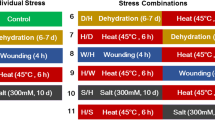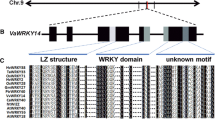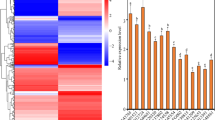Abstract
AtWRKY30 belongs to a higher plant transcription factor superfamily, which responds to pathogen attack. In previous studies, the AtWRKY30 gene was found to be highly and rapidly induced in Arabidopsis thaliana leaves after oxidative stress treatment. In this study, electrophoretic mobility shift assays showed that AtWRKY30 binds with high specificity and affinity to the WRKY consensus sequence (W-box), and also to its own promoter. Analysis of the AtWRKY30 expression pattern by qPCR and using transgenic Arabidopsis lines carrying AtWRKY30 promoter-β-glucuronidase fusions showed transcriptional activity in leaves subjected to biotic or abiotic stress. Transgenic Arabidopsis plants constitutively overexpressing AtWRKY30 (35S::W30 lines) were more tolerant than wild-type plants to oxidative and salinity stresses during seed germination. The results presented here show that AtWRKY30 is responsive to several stress conditions either from abiotic or biotic origin, suggesting that AtWRKY30 could have a role in the activation of defence responses at early stages of Arabidopsis growth by binding to W-boxes found in promoters of many stress/developmentally regulated genes.








Similar content being viewed by others
References
Boyes DC, Zayed AM, Ascenzi R, McCaskill AJ, Hoffman NE, Davis KR, Gorlach J (2001) Growth stage-based phenotypic analysis of Arabidopsis: a model for high throughput functional genomics in plants. Plant Cell 13:1499–1510
Chen C, Chen Z (2000) Isolation and characterization of two pathogen- and salicylic acid-induced genes encoding WRKY DNA-binding proteins from tobacco. Plant Mol Biol 42:387–396
Ciolkowski I, Wanke D, Birkenbihl RP, Somssich IE (2008) Studies on DNA-binding selectivity of WRKY transcription factors lend structural clues into WRKY-domain function. Plant Mol Biol 68:81–92
Clough SJ, Bent AF (1998) Floral dip: a simplified method for Agrobacterium-mediated transformation of Arabidopsis thaliana. Plant J 16:735–743
Cormack RS, Eulgem T, Rushton PJ, Kochner P, Hahlbrock K, Somssich IE (2002) Leucine zipper-containing WRKY proteins widen the spectrum of immediate early elicitor-induced WRKY transcription factors in parsley. Biochim Biophys Acta 1576:92–100
Czechowski T, Stitt M, Altmann T, Udvardi MK, Scheible WR (2005) Genome-wide identification and testing of superior reference genes for transcript normalization in Arabidopsis. Plant Physiol 139:5–17
Dong J, Chen C, Chen Z (2003) Expression profiles of the Arabidopsis WRKY gene superfamily during plant defense response. Plant Mol Biol 51:21–37
Du L, Chen Z (2000) Identification of genes encoding receptor-like protein kinases as possible targets of pathogen- and salicylic acid-induced WRKY DNA-binding proteins in Arabidopsis. Plant J 24:837–847
Eulgem T, Somssich IE (2007) Networks of WRKY transcription factors in defense signalling. Curr Opin Plant Biol 10:366–371
Eulgem T, Rushton PJ, Robatzek S, Somssich IE (2000) The WRKY superfamily of plant transcription factors. Trends Plant Sci 5:199–206
Fahnenstich H, Scarpeci TE, Valle EM, Flugge UI, Maurino VG (2008) Generation of hydrogen peroxide in chloroplasts of Arabidopsis overexpressing glycolate oxidase as an inducible system to study oxidative stress. Plant Physiol 148:719–729
Fujita M, Fujita Y, Noutoshi Y, Takahashi F, Narusaka Y, Yamaguchi-Shinozaki K, Shinozaki K (2006) Crosstalk between abiotic and biotic stress responses: a current view from the points of convergence in the stress signalling networks. Curr Opin Plant Biol 9:436–442
Gapper C, Dolan L (2006) Control of plant development by reactive oxygen species. Plant Physiol 141:341–345
Heslop-Harrison J, Heslop-Harrison Y (1985) Germination of stress-tolerant Eucalyptus pollen. J Cell Sci 73:135–157
Higo K, Ugawa Y, Iwamoto M, Korenaga T (1999) Plant cis-acting regulatory DNA elements (PLACE) database. Nucleic Acids Res 27:297–300
Jiang M, Zhang J (2003) Cross-talk between calcium and reactive oxygen species originated from NADPH oxidase in abscisic acid-induced antioxidant defence in leaves of maize seedlings. Plant, Cell Environ 26:929–939
Journot-Catalino N, Somssich IE, Roby D, Kroj T (2006) The transcription factors WRKY11 and WRKY17 act as negative regulators of basal resistance in Arabidopsis thaliana. Plant Cell 18:3289–3302
Kalde M, Barth M, Somssich IE, Lippok B (2003) Members of the Arabidopsis WRKY group III transcription factors are part of different plant defense signalling pathways. Mol Plant Microbe Interact 16:295–305
Koschmann J, Machens F, Becker M, Niemeyer J, Schulze J, Bülow L, Stahl DJ, Hehl R (2012) Integration of bioinformatics and synthetic promoters leads to discovery of novel elicitor-responsive cis-regulatory sequences in Arabidopsis thaliana. Plant Physiol. doi:10.1104/pp.112.198259
Lippok B, Birkenbihl RP, Rivory G, Brümmer J, Schmelzer E, Logemann E, Somssich IE (2007) Expression of AtWRKY33 encoding a pathogen- or PAMP-responsive WRKY transcription factor is regulated by a composite DNA motif containing W box elements. Mol Plant Microbe Interact 20:420–429
Livak KJ, Schmittgen TD (2001) Analysis of relative gene expression data using real-time quantitative PCR and the 2(-Delta Delta C(T)) Method. Methods 25:402–408
Lu D, Lin W, Gao X, Wu S, Cheng C, Avila J, Heese A, Devarenne TP, He P, Shan L (2011) Direct ubiquitination of pattern recognition receptor FLS2 attenuates plant innate immunity. Science 332:1439–1442
Mao G, Meng X, Liu Y, Zheng Z, Chen Z, Zhang S (2011) Phosphorylation of a WRKY transcription factor by two pathogen-responsive MAPKs drives phytoalexin biosynthesis in Arabidopsis. Plant Cell 23(4):1639–1653
McInnis SM, Desikan R, Hancock JT, Hiscock SJ (2006) Production of reactive oxygen species and reactive nitrogen species by angiosperm stigmas and pollen: potential signalling crosstalk? New Phytol 172:221–228
Murata Y, Pei ZM, Mori IC, Schroeder J (2001) Abscisic acid activation of plasma membrane Ca(2 +) channels in guard cells requires cytosolic NAD(P)H and is differentially disrupted upstream and downstream of reactive oxygen species production in abi1-1 and abi2-1 protein phosphatase 2C mutants. Plant Cell 13:2513–2523
Nylander M, Svensson J, Palva ET, Welin BV (2001) Stress-induced accumulation and tissue-specific localization of dehydrins in Arabidopsis thaliana. Plant Mol Biol 45:263–279
Park HC, Kim ML, Kang YH, Jeon JM, Yoo JH, Kim MC, Park CY, Jeong JC, Moon BC, Lee JH, Yoon HW, Lee SH, Chung WS, Lim CO, Lee SY, Hong JC, Cho MJ (2004) Pathogen- and NaCl-induced expression of the SCaM-4 promoter is mediated in part by a GT-1 box that interacts with a GT-1-like transcription factor. Plant Physiol 135:2150–2161
Pei ZM, Murata Y, Benning G, Thomine S, Klusener B, Allen GJ, Grill E, Schroeder JI (2000) Calcium channels activated by hydrogen peroxide mediate abscisic acid signalling in guard cells. Nature 406:731–734
Rober M, Geider K, Muller-Rober B, Willmitzer L (1996) Synthesis of fructans in tubers of transgenic starch-deficient potato plants does not result in an increased allocation of carbohydrates. Planta 199:528–536
Rushton PJ, Torres JT, Parniske M, Wernert P, Hahlbrock K, Somssich IE (1996) Interaction of elicitor-induced DNA-binding proteins with elicitor response elements in the promoters of parsley PR1 genes. EMBO J 15:5690–5700
Salinas-Mondragon RE, Garciduenas-Pina C, Guzman P (1999) Early elicitor induction in members of a novel multigene family coding for highly related RING-H2 proteins in Arabidopsis thaliana. Plant Mol Biol 40:579–590
Sambrook J, Russell DW (2001) Molecular cloning: a laboratory manual. CSHL Press, Cold Spring Harbor, New York
Scarpeci TE, Marro ML, Bortolotti S, Boggio SB, Valle EM (2007) Plant nutritional status modulates glutamine synthetase levels in ripe tomatoes (Solanum lycopersicum cv. Micro-Tom). J Plant Physiol 164:137–145
Scarpeci TE, Zanor MI, Carrillo N, Mueller-Roeber B, Valle EM (2008) Generation of superoxide anion in chloroplasts of Arabidopsis thaliana during active photosynthesis: a focus on rapidly induced genes. Plant Mol Biol 66:361–378
Sgro G, Ficarra F, Dunger G, Scarpeci T, Valle EM, Orellano E, Gottig N, Ottado J (2012) Contribution of a harpin protein from Xanthomonas axonopodis pv. citri to pathogen virulence. Mol Plant Pathol 13:1047–1059
Smale ST, Kadonaga JT (2003) The RNA polymerase II core promoter. Annu Rev Biochem 72:449–479
Wildermuth MC, Dewdney J, Wu G, Ausubel FM (2001) Isochorismate synthase is required to synthesize salicylic acid for plant defence. Nature 414:562–565
Yamamoto YY, Ichida H, Matsui M, Obokata J, Sakurai T, Satou M, Seki M, Shinozaki K, Abe T (2007) Identification of plant promoter constituents by analysis of local distribution of short sequences. BMC Genomics 8:67
Yamasaki K, Kigawa T, Inoue M, Tateno M, Yamasaki T, Yabuki T, Aoki M, Seki E, Matsuda T, Tomo Y, Hayami N, Terada T, Shirouzu M, Tanaka A, Seki M, Shinozaki K, Yokoyama S (2005) Solution structure of an Arabidopsis WRKY DNA binding domain. Plant Cell 17:944–956
Yu D, Chen C, Chen Z (2001) Evidence for an important role of WRKY DNA binding proteins in the regulation of NPR1 gene expression. Plant Cell 13:1527–1540
Zhang X, Zhang L, Dong F, Gao J, Galbraith DW, Song CP (2001) Hydrogen peroxide is involved in abscisic acid-induced stomatal closure in Vicia faba. Plant Physiol 126:1438–1448
Zou C, Sun K, Mackaluso JD, Seddon AE, Jin R, Thomashow MF, Shiu SH (2011) Cis-regulatory code of stress-responsive transcription in Arabidopsis thaliana. Proc Natl Acad Sci USA 108:14992–14997
Acknowledgments
The work described in this article was performed with the financial support of the Agencia Nacional de Promoción Científica y Tecnológica (ANPCyT) and the Consejo Nacional de Investigaciones Científicas y Técnicas (CONICET) from Argentina. Bernd Mueller-Roeber thanks the Fond der Chemischen Industrie for funding (No. 0164389).
Author information
Authors and Affiliations
Corresponding author
Electronic supplementary material
Below is the link to the electronic supplementary material.
11103_2013_90_MOESM1_ESM.tif
Supplementary Fig. 1 DNA binding assay of recombinant AtWRKY30 protein to 32P-labelled SP promoter fragment (0.28 kb) encompassing four W-boxes (Fig. 1). Total recombinant AtWRKY30 protein extract (40 μg) from E. coli was used for DNA binding assays with 0.28 kb 32P-labelled promoter fragment (+). As a control, total protein extract (40 μg) from E. coli that did not produce recombinant AtWRKY30 protein was used (-). FP: free probe. (TIFF 2760 kb)
11103_2013_90_MOESM2_ESM.tif
Supplementary Fig. 2 GUS activity in LP #1 transgenic plants. (a) Scheme of plasmid pBI101 with 1.96 kb (LP) DNA fragment from the AtWRKY30 promoter cloned upstream of the β-glucuronidase gene. (b) Leaves were subjected to biotic, abiotic and hormone treatments. LP #1 plants were treated with a solution containing: 20 mM H2O2, 100 mM NaCl, 200 mM mannitol or 100 μM sodium arsenate all in 0.005 % (v/v) Silwet L-77, and incubated for 4 h, or kept without watering for 15 days and then re-watered (indicated as drought). Biotic treatments were assayed by syringe infiltration with X. axonopodis or P. syringae pv. tomato DC3000 (108 cfu ml−1) or by vacuum infiltrating leaves with bacterial (A. tumefaciens) elicitor. The left half of a leaf infiltrated with a solution without A. tumefaciens is also shown. The arrows indicate the site of infiltration using a syringe with the X. axonopodis or P. syringae bacterial suspension or with MgCl2 (control) and the wounded tissue in the A. tumefaciens treated leaf. For hormone treatments, leaves were incubated with 5 mM ethephon, 100 μM ACC or 100 μM MeJA. Representative images are shown. (TIFF 15192 kb)
11103_2013_90_MOESM3_ESM.tif
Supplementary Fig. 3 GUS staining detected in SP #1 line. (a) Scheme of plasmid pBI101 with the 0.28 kb (SP) DNA fragment from the AtWRKY30 promoter cloned upstream of β-glucuronidase gene. (b) AtWRKY30 promoter activity was followed by histochemical localization of GUS activity in leaves or cauline leaves after 24 h of 200 mM mannitol or 100 mM NaCl treatment. Representative images are shown. (TIFF 6932 kb)
11103_2013_90_MOESM4_ESM.tif
Supplementary Fig. 4 Fresh weight (in mg) of seedlings after growth on (a) 1 μM MV or (b) 150 mM NaCl; shown are data for 35S::W30-1, 35S::W30-8, 35S::W30-21, empty vector control (EV) and wild type (Col-0) plants. Age-matched seeds of all lines were germinated in parallel on 0.5x MS agar plates containing either MV or NaCl and scoring was carried out after 10 days of treatment. Error bars represent the SE over three replicate experiments, each including at least 30 plants of each line. Experimental data were subjected to One-way ANOVA test. Significant difference between Col-0 and 35S::W30 plants (P < 0.05) is indicated by an asterisk. (TIFF 7202 kb)
11103_2013_90_MOESM5_ESM.tif
Supplementary Fig. 5 GUS staining detected in LP #1 line during germination. Seeds from LP #1 line were germinated and grown in MS 0.5x agar plates (a), MS 0.5x agar plates supplemented with 0.5 μM MV (b) or 100 mM NaCl (c). GUS staining was carried out when seedlings were four, six and eight-day-old. Representative images are shown. (TIFF 8387 kb)
Rights and permissions
About this article
Cite this article
Scarpeci, T.E., Zanor, M.I., Mueller-Roeber, B. et al. Overexpression of AtWRKY30 enhances abiotic stress tolerance during early growth stages in Arabidopsis thaliana . Plant Mol Biol 83, 265–277 (2013). https://doi.org/10.1007/s11103-013-0090-8
Received:
Accepted:
Published:
Issue Date:
DOI: https://doi.org/10.1007/s11103-013-0090-8




